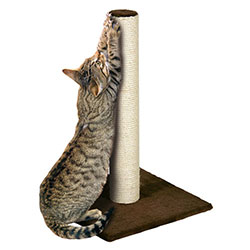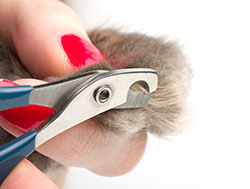Claws for concern?
Thinking of declawing your cat? Please don't!

Admittedly, having a house full of shredded upholstery or scratched wooden fixtures is unsightly and annoying, and waking up with pin pricks in your flesh from an affectionate cat "kneading dough" is painful, but declawing a cat is not a good answer to the problem. Far from being a simple procedure, declawing is painful both physically and psychologically to the cat, and it can lead to other health and behavioural problems.
Scratching more than a bad habit
Cats scratch for four important reasons. First, scratching is a form of grooming that removes old nail husks. These can become overgrown if not shed routinely, and this will create problems with mobility. Second, scratching is a defence mechanism. Cats are small in size compared to potential threats such as a dog or raccoon, and a cat needs an equaliser for his or her protection. One swipe across the nose of an aggressor with claws extended can thwart a full-on attack and may mean the difference between life and death for a cat. Take away the cat's ability to defend him or herself, and the cat may become timid or overly aggressive. Declawed cats often become biters. Third, a cat communicates with other cats by way of scratch marks left in the area. A cat is marking his or her territory by scratching, and also alerts other animals of the fact that a cat lives in the area. Taking away the ability to scratch through declawing would be like taking away a teenager's cell phone. Fourth, cats exercise by scratching. It is common for a cat to stand on his or her hind legs, reach far overhead and scratch intensely. This exercises the muscles in the cat's front legs and also offers a full-body stretch that both limbers and distresses the cat. In short, scratching serves many purposes in a cat's life, and a healthy, happy cat needs the opportunity and the ability to scratch.
Declawing means amputation of the toes
A cat's claw is a part of the last bone of its toe, and the process of declawing involves the surgical removal of all ten of the toes at the last joint. Declawing is not a simple surgery. It involves removal of claw, bone, ligament and tendons. It is painful to the cat, and may impede its ability to walk, jump or use the litter box soon after surgery. It would be similar to removing the tips of each of a human's fingers, and then expecting them to be able to type or send text messages a few hours later.
More dangerous complications include bleeding, infection and nerve damage that creates painful sensations that is not dissimilar to that experienced by human amputees in what is termed a "phantom limb." European countries have banned the practice of declawing on the basis that it is inhumane, and many animal shelters will not allow a cat to be adopted if the prospective owner plans to declaw the animal.

Trimming can help if your cats sharp claws are a problem
Alternatives to declawing:
1) Offer surfaces that are acceptable to scratch. The scratching post and climbing tree were created to offer indoor cats safe, acceptable alternatives to household furniture for scratching, climbing and lounging. Scratch posts and cat trees come covered in a variety of surfaces: bark-covered wood, sisal rope, carpeting or upholstery, and one or more of these should entice a cat to use it rather than the furniture for his or her scratching urges. To help train the cat to use a post or tree, sprinkle or rub catnip into the fabric and let the cat observe and explore. Or, when the cat moves to scratch the furniture, pick the cat up and place him or her near the tree. Lift a paw and put it on the post, so the cat connects scratching with that item. Praise the cat when it goes to the post of its own accord.
2) Trim the cat's nails regularly. Pet stores offer nail trimmers that are specially constructed to fit and trim a cat's claws safely. Alternately, take the cat to the veterinarian or a groomer and have him or her trim the claws as a part of the cat's routine maintenance.
3) Use nail caps. Nail caps are made of a soft, pliable material that is fixed to the cat's nails with adhesive. The caps fit snugly to the nail and are thin enough that the cat doesn't feel them, but they protect surfaces by adding a soft layer between the sharp point of the claw and the furniture, rug or skin. Nail caps come in clear and white, but there are also coloured and glittered caps that turn any house cat into a feline fashionista.
One final note
The major justification for declawing is that it saves cats from animal shelters because they are less destructive house pets. However, a 1996 study published in the Journal of the American Veterinary Medical Association showed that declawed cats actually are more likely to be turned over to animal shelters. The pain of declawing often makes a cat stop using the litter box completely, and a declawed cat may develop defensive behaviours such as biting that make it less of a companion, especially in a household with children. Training a cat to use a scratching post or tree and using nail caps on indoor animals are far better methods of preventing scratching disasters than is declawing an animal.


















